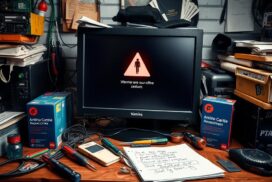Repairing Short Circuits in Desktop Computer Systems
When it comes to desktop computers, short circuits can be a real headache. These hardware faults can cause unexpected shutdowns or even prevent your computer from powering on altogether. But fear not, because in this article, we will guide you through the process of repairing short circuits in desktop computer systems.
Before diving into the troubleshooting steps, it’s crucial to ensure your safety. Always remember to power off and unplug your PC before attempting to fix any electrical shorts. This will protect you from potential hazards and further damage to your system.
Once you have taken the necessary precautions, the first step in short circuit repair is to inspect the motherboard for loose or stray screws. These metal pieces can accidentally create an unintended electrical connection, leading to short circuits. Additionally, carefully examine all cables and wires for any signs of damage that may be contributing to the issue.
Short circuits in desktop computers can have several causes. One common culprit is stray screws that come into contact with the motherboard or other internal components. Exposed or damaged wires within the computer can also lead to short circuits. Furthermore, defective components such as graphics cards or hard drives can contribute to these electrical faults.
To troubleshoot short circuits, you can start by checking if the circuit breaker trips when your PC is in use. If this happens, it could indicate an overloaded circuit. Unplug unnecessary devices and consider connecting your computer to a different circuit to alleviate the strain.
Another potential cause of short circuits is a faulty power supply. You can test this by substituting it with a known working power supply or replacing it altogether if necessary.
Inspecting internal wiring for loose or damaged cables is also recommended when troubleshooting short circuits. However, if you’re unsure or uncomfortable performing these repairs yourself, it’s best to seek professional assistance from a computer repair technician.
In conclusion, by understanding the common causes of short circuits in desktop computers and following the appropriate troubleshooting steps, you can effectively address and resolve these hardware faults. Remember to prioritize your safety and seek professional help when needed to ensure a reliable and safe computing experience.
Common Causes of Short Circuits in Desktop Computers
Short circuits in desktop computers can be caused by a variety of factors, leading to potential data loss and system malfunctions. It is crucial to identify these causes and take necessary precautions to ensure the smooth operation of your desktop computer.
1. Stray Screws
One common cause of short circuits in desktop computers is the presence of stray screws inside the computer case. These screws can come into contact with the motherboard or other internal components, causing unintended electrical connections. This can disrupt the flow of electricity and potentially damage the system.
2. Exposed or Damaged Wires
Exposed or damaged wires within the computer can pose a significant risk of short circuits. When these wires come into contact with internal components, they can create electrical pathways that were not intended by the design. This can lead to unexpected power surges, system shutdowns, and even irreversible damage.
3. Faulty Power Supplies and Defective Components
Another common cause of short circuits in desktop computers is the presence of faulty power supplies or defective components such as graphics cards or hard drives. These components can generate excessive heat or draw an abnormal amount of power, increasing the chances of a short circuit occurrence. It is essential to regularly check and replace any malfunctioning hardware to prevent potential damage to your computer.
In the event of a short circuit, the circuit breaker in your home may trip to protect against potential electrical hazards. However, this can also lead to the loss of important data if the computer abruptly shuts down. Therefore, it is crucial to address the causes of short circuits and take preventive measures to minimize the risk of data loss and system interruptions.
By understanding the common causes of short circuits in desktop computers, you can take proactive steps to prevent these issues, safeguard your data, and ensure the longevity of your computer system.
| Cause | Description |
|---|---|
| Stray Screws | Loose screws inside the computer case that come into contact with internal components, creating unintended electrical connections. |
| Exposed or Damaged Wires | Wires within the computer that are exposed or damaged, leading to unexpected electrical pathways and potential short circuits. |
| Faulty Power Supplies and Defective Components | Malfunctioning power supplies or defective components such as graphics cards or hard drives that generate excessive heat or draw abnormal power, increasing the risk of short circuits. |
Troubleshooting Short Circuits in Desktop Computers
When it comes to troubleshooting short circuits in desktop computers, there are several important steps you can take to identify and resolve the issue. By following these steps, you can get your computer up and running smoothly again.
1. Check for an Overloaded Circuit
If your circuit breaker trips when your PC is in use, it may be due to an overloaded circuit. To troubleshoot this, unplug any unnecessary devices connected to the same circuit and try using a different circuit if possible. This can help determine if the issue lies with an overloaded circuit.
2. Inspect the Power Supply
A faulty power supply is another common cause of short circuits in desktop computers. To troubleshoot this, you can try replacing the power supply with a known working unit or use a substitute power supply for testing. If the short circuit issue is resolved with the substitution, it may be necessary to replace the power supply.
3. Examine Internal Wiring
Loose or damaged cables inside the computer can contribute to short circuits. During troubleshooting, carefully inspect the internal wiring for any loose connections or signs of damage. Ensure all cables are properly secured and not in contact with any sharp edges or components. If any cables appear damaged, they should be replaced.
4. Seek Professional Assistance
If you are unsure about performing troubleshooting steps on your own, it is always advisable to seek professional computer repair assistance. A trained technician can diagnose the issue accurately and provide the necessary repairs or replacements to fix the short circuit problem.
“Troubleshooting short circuits in desktop computers requires careful inspection and testing. By following these steps and seeking professional help if needed, you can resolve short circuit issues and ensure the safe operation of your computer.” – Computer Repair Specialist
Remember to always prioritize your safety when working with electrical systems. If you are uncomfortable or uncertain about any troubleshooting steps, it’s best to consult a professional to avoid any potential hazards.
| Troubleshooting Steps | Benefits |
|---|---|
| Check for an overloaded circuit | Determines if the circuit breaker trips due to excess electrical load |
| Inspect the power supply | Identifies any faults that may be causing the short circuit |
| Examine internal wiring | Detects loose or damaged cables that could be contributing to the issue |
| Seek professional assistance | Ensures accurate diagnosis and expert repair for complex issues |
Remember, understanding the troubleshooting steps for short circuits in desktop computers can help you address and resolve these issues effectively, ensuring the smooth operation and longevity of your system.
Importance of Circuit Breakers in Protecting Your Home’s Electrical Circuits
Circuit breakers play a vital role in ensuring the safety of your home’s electrical circuits. They serve as a protective barrier against potential hazards such as overloads and short-circuits, safeguarding both your property and the people living in it. By detecting excess current flow, circuit breakers act as a safety mechanism that interrupts the electrical circuit before any damage occurs.
Without circuit breakers, the risk of electrical fires, shocks, and other potential hazards would be significantly higher. These safety devices are designed to proactively prevent dangerous situations by tripping and shutting off the power supply whenever necessary.
When an electrical circuit becomes overloaded or a short-circuit occurs, the circuit breaker quickly responds by interrupting the flow of electricity. This rapid action helps prevent overheating, which can lead to electrical fires. It also protects your valuable electronic devices from damage caused by excessive currents.
Builders and electricians prioritize the installation of circuit breakers in residential electrical systems to ensure the utmost safety. These professionals design and implement electrical safety systems that include circuit breakers as a fundamental component. By disconnecting circuits when dangerous levels of current are reached, circuit breakers effectively mitigate potential risks in homes, giving residents peace of mind.
The Science Behind Circuit Breakers and Electricity
Electricity is the movement of electrical charge from one atom to another, and it is derived from primary energy sources. This flow of charge allows us to power our homes, run appliances, and operate electronic devices. Understanding the basics of electricity and how it relates to circuit breakers is crucial for maintaining electrical safety.
At the heart of electrical systems are three key components: voltage, current, and resistance. Voltage represents the pressure that drives the electric charge through a circuit. It can be compared to water pressure in a pipe. The higher the voltage, the more forceful the flow of electrical charge.
Current is the rate at which the electrical charge flows through a circuit. It is measured in amperes (A) and can be thought of as the quantity or volume of electrical charge passing through a point in a given time. Similar to the flow rate of water in a pipe, the higher the current, the greater the amount of electrical charge passing through the circuit per unit of time.
Resistance is the opposition to the flow of electrical charge in a circuit. It is determined by the material the current passes through and is measured in ohms (Ω). Think of resistance as a narrowing in the pipe that reduces the flow of water. In an electrical circuit, resistance can be caused by factors such as the length and thickness of the wire or the presence of components like resistors.
Circuit breakers play a vital role in electrical systems by detecting excess current flow. When a short circuit or an overloaded circuit occurs, the circuit breaker responds by opening the circuit, interrupting the flow of electricity. This action protects the circuit and prevents potential electrical hazards such as fires or damage to equipment.
“Circuit breakers act as safety devices to safeguard against potential electrical hazards. They detect excess current flow, protect circuits from damage, and ensure the safety of your home.”
When a circuit breaker detects excess current flow, it trips or opens the circuit, breaking the flow of electricity. This action prevents the circuit from overheating and causing damage. Once the fault is resolved or the overload is removed, the circuit breaker can be reset to restore the flow of electricity through the circuit.
By monitoring the flow of electrical current and interrupting it when necessary, circuit breakers serve as essential safety devices in electrical installations. They provide a reliable and effective means of protecting against potential electrical hazards. Understanding the science behind circuit breakers and electricity empowers individuals to make informed decisions about electrical safety in their homes and workplaces.
The Role of Voltage, Current, and Resistance in Electrical Systems
In electrical systems, voltage, current, and resistance are interconnected and play crucial roles. They form the foundation for understanding how electricity behaves and how circuit breakers function.
- Voltage: Represents the pressure or force driving the flow of electrical charge.
- Current: Measures the rate at which electrical charge flows through a circuit.
- Resistance: Opposes the flow of electrical charge in a circuit.
When there is an imbalance in any of these components, such as a short circuit or an overload, circuit breakers act as safeguards by interrupting the flow of electricity. This protective action prevents potential damage and hazards, ensuring the safety and reliability of electrical systems.
Conclusion
Repairing short circuits in desktop computer systems is crucial to prevent potential damage and data loss. When faced with a short circuit issue, understanding the common causes and following proper troubleshooting steps can help you efficiently address the problem. It is also important to prioritize electrical safety to ensure a reliable and safe computing experience.
Short circuits in desktop computers can be caused by various factors such as stray screws, damaged wires, or faulty components. By inspecting and securing the internal components, you can prevent further damage. Additionally, having a circuit breaker installed in your home is essential to protect your electrical circuits from being overloaded or short-circuited, minimizing hazards like electrical fires or shocks.
If you are unsure or uncomfortable with repairing short circuits yourself, it is recommended to seek professional help. They have the expertise to diagnose and resolve the issue while ensuring your safety. Always remember to power off and unplug the computer before attempting any repairs to avoid accidents.
FAQ
How do I repair a short circuit in my desktop computer system?
To repair a short circuit in a desktop computer system, it is important to first power off and unplug the PC before troubleshooting electrical shorts. Check for loose or stray screws that may be in contact with the motherboard and inspect cables and wires for any damage.
What are the common causes of short circuits in desktop computers?
Short circuits in desktop computers can be caused by various factors. One common cause is stray screws inside the computer case that come into contact with the motherboard or other internal components. Another cause is exposed or damaged wires within the computer that touch internal components. Additionally, faulty power supplies or defective components such as graphics cards or hard drives can also lead to short circuits.
What should I do if the circuit breaker trips when my PC is in use?
If the circuit breaker trips when the PC is in use, it could be due to an overloaded circuit. Unplug unnecessary devices and consider moving the PC to a different circuit. A faulty power supply can also cause short circuits. Test with a substitute power supply or replace the power supply if necessary. Inspecting internal wiring for loose or damaged cables is another troubleshooting step. If unsure, seek professional computer repair assistance.
What is the role of circuit breakers in protecting electrical circuits in homes?
Circuit breakers play a vital role in safeguarding your home’s electrical circuits from being overloaded or short-circuited. They detect excess current flow and trip to shut off the power, preventing potential hazards such as electrical fires or shocks. Without circuit breakers, the risk of these hazards would be significantly higher.
How do circuit breakers work and what is the relationship between electricity and circuit breakers?
Electricity is the movement of electrical charge from one atom to another and is derived from primary energy sources. Voltage represents the pressure driving the electric charge, while current is the rate at which the charge flows. Resistance occurs when the current interacts with a conductor material. Circuit breakers detect excess current flow, which can occur due to short circuits or overloaded circuits. They act as safety devices to protect against potential electrical hazards in homes.
Why is it important to repair short circuits in desktop computer systems?
Repairing short circuits in desktop computer systems is important to prevent potential damage and data loss. By understanding the common causes of short circuits, troubleshooting steps, and the role of circuit breakers in protecting electrical circuits, you can effectively address and resolve short circuit issues. Prioritizing electrical safety and seeking professional help if needed ensures a reliable and safe computing experience.












